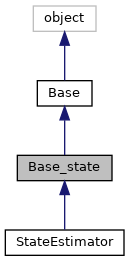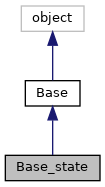Inheritance diagram for Base_state:

Collaboration diagram for Base_state:

Public Member Functions | |
| def | __init__ (self, signal_number, state_number, signal_cache_limit=1000, state_cache_limit=1000, signal_names=[], state_names=[]) |
| def | get_states (self) |
| def | measure (self, List cur_signals) |
| def | parse (self, cur_signals) |
| def | update (self, cur_signals, cur_states) |
| def | visualize_state_evolving (self, fh=None) |
 Public Member Functions inherited from Base Public Member Functions inherited from Base | |
| def | __init__ (self) |
| def | adapt (self) |
| def | correct (self) |
| def | measure (self, signal) |
| def | predict (self) |
| def | process (self, signal) |
Public Attributes | |
| f_idx | |
| signal_cache_count | |
| signal_cache_limit | |
| signal_names | |
| signal_number | |
| signals_cache | |
| state_cache_count | |
| state_cache_limit | |
| state_names | |
| state_number | |
| states_cache | |
 Public Attributes inherited from Base Public Attributes inherited from Base | |
| x | |
Detailed Description
The base class for the human state estimator. @param[in] signal_number how many signals will be used as input @param[in] state_number how many states will be estimated @param[in] signal_cache_limit How many previous signals to be stored. Default:1000 @param[in] state_cache_limit How many previous states to be stored. Default:1000 @param[in] signal_names A list of signal names. If empty then will assign signal_1, signal_2, ... @param[in] state_names A list of state names. If empty then will assign state_1, state_2, ...
Constructor & Destructor Documentation
◆ __init__()
| def __init__ | ( | self, | |
| signal_number, | |||
| state_number, | |||
signal_cache_limit = 1000, |
|||
state_cache_limit = 1000, |
|||
signal_names = [], |
|||
state_names = [] |
|||
| ) |
Member Function Documentation
◆ get_states()
| def get_states | ( | self | ) |
Get the latest state.
Returns:
latest_state (binary, (N_state, )). The last binary states. N_states is the number of the state
◆ measure()
| def measure | ( | self, | |
| List | cur_signals | ||
| ) |
The workflow of the signal2state @param[in] cur_signals. An array of the signals, each element of which represents the new income of different signal types
◆ parse()
| def parse | ( | self, | |
| cur_signals | |||
| ) |
Parse the state out of the signals. Return the states
◆ update()
| def update | ( | self, | |
| cur_signals, | |||
| cur_states | |||
| ) |
Update the cache states with new ones
◆ visualize_state_evolving()
| def visualize_state_evolving | ( | self, | |
fh = None |
|||
| ) |
Monitor the state process by plotting a line chart using the plt.
Will only display the cached states, which is the latest state_cache_limit states
@param[in] fh The figure handle. Default is None. When set to None then a new figure will be created
Note that the fh will be stored at the first time being used, and all future drawing will be on that figure
Member Data Documentation
◆ f_idx
| f_idx |
◆ signal_cache_count
| signal_cache_count |
◆ signal_cache_limit
| signal_cache_limit |
◆ signal_names
| signal_names |
◆ signal_number
| signal_number |
◆ signals_cache
| signals_cache |
◆ state_cache_count
| state_cache_count |
◆ state_cache_limit
| state_cache_limit |
◆ state_names
| state_names |
◆ state_number
| state_number |
◆ states_cache
| states_cache |
The documentation for this class was generated from the following file:
- /local/source/python/Surveillance/Surveillance/activity/state.py